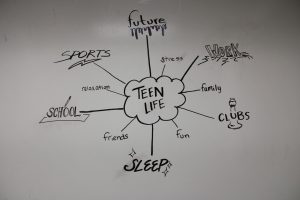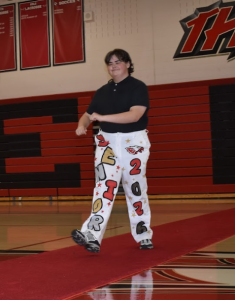Mental Health & EHS
May 13, 2019
Being a student in today’s world means dealing with mental health. Cherry Creek School District data shows that from 2014-2018 there has been overall 5% increase of high school students who reported having depressive symptoms. In 2018 over 55% of high school students told no one about their suicidal thoughts.
“A lot of people still struggle with admitting they have a mental health issue. I think it mirrors society,” Barbara Edwards, an EHS psychologist, explained.
EHS has 3 mental health professionals and 10 counselors for a growing population of over three-thousand students. The ratio of students to mental health professionals makes it hard to have tough conversations.
Mental health is broken into levels which are created to stop such a large influx of people from going to a department that is already stretched in terms of personnel. It creates a separation to decide which students need to go to the next step and which students just need to talk to someone. But this small staff means some students feel misunderstood when trying to discuss mental health issues.
“I think by listening. The older I get the more I am really aware I don’t live the same kind of life. We don’t pretend to know what the students life always looks like,” Johnson.
Due to the ratio of students to counselors and mental health professionals, it is hard to build a connection with each and every student unless the student makes an effort as well. From a student’s perspective however, the counseling and mental health team tries too hard to be objective on issues.
Johnson explained, “We don’t have the resources to say we can tailor this to you. We’re at school that’s not how we’re structured. We want the student to direct what they want.”
However many students I talked to , including friends of Anthony Hernandez, a junior who completed suicide last year, felt little support in their grieving process.
“All the counselors never seemed to care enough. It’s supposed to be their job and yet they’re still telling you you should probably be over it,” commented CJ Martinez.
Other students have found that the problem doesn’t lie within the staff of counselors. There is only so much the school can do.
Mia Stretz stated, “I know that [counseling and mental health] probably try their best. I think that they need to spend a little more resources on fixing problems especially since mental health is becoming more of a problem in society.”
That’s what students need to keep in mind. Eaglecrest is a high school not a hospital and while the counselors want to do more sometimes they can’t do everything. That’s not to say conversations about mental health need to stop in school, we all have to be cognizant of each side.
“The goal of the counseling department is to help kids feel better so they can go back to class so they are not missing class,” Johnson explained.
Last year, after Anthony’s passing, many of his friends felt the issue was swept under the rug. In times of grief many students have a hard time accepting district processes where grief counselors only visit the classes the student was in because of district policy concerning contagion, the idea that the more attention that is put on a suicide, the more people that could be triggered and repeat the event.
“Research shows that it’s better to communicate with students who have recent interactions rather than making a mass announcement,” Edwards explained regarding how EHS responded to Hernandez’s suicide.
A simple solution to most of these concerns would be to grow the staff of counselors and mental health professionals at our school, but it’s not that easy when budgeting activities for such a large school.
David Brown, EHS assistant principal, stated, “We need at least 3 [mental health workers] and to be honest with you I’d like to see 4. I really would because that would divide it up a little over 750 per staff member. And I still think that’s coming up short.”
There are certain processes to deal with how to help a student in need. Since teachers have a closer connection to students than most counselors the teachers are trained to listen to students, but not trained to be their counselors. In any extreme case or if a teacher is worried about a student, the teacher is supposed to pass on concerns to the counseling department.
“When it gets to the point of them sharing some things that are self harm or suicidal thoughts or a danger to others or they know of a danger, then it is [the teachers] responsibility to come and share it with someone,” Johnson explained.
There are also few opportunities to teach students about mental health. The challenge continues as both teachers and students don’t know how to approach mental health discussions without triggering anyone.
In health class, there is a unit that goes over mental health and the illnesses that some may deal with. For about five days the health class goes over each unit, which isn’t enough time to go in depth with a lot of mental health issues. The unit is focused on helping students advocate for themselves and for stress relief.
“The biggest message we give them is don’t ever feel like there’s nobody there. There’s always somebody to talk to,” stated Poulter.
The new line for students is Safe2Tell and more information can be found in the resource box on the side of this page.
Freshmen are also shown a Signs of Suicide (SOS) video to watch. The SOS video is one of the few conversations students have about mental illness throughout high school.
“We had to sit there and watch a bunch of videos, but it wasn’t helpful,” Hance expressed.
These videos are shown once a year, and while they aren’t the most effective tool 100% of the time they do allow conversations to start regarding mental health. That’s all students want is to have a conversation through their years of school just like how we would talk about study habits.
Stretz stated, “I think it was more common knowledge rather than factual stuff so that’s an issue.”
As Lexi Ruiz explained, “It shouldn’t be ‘Oh let me show you a video of this.’ because it’s different seeing it on a video than actually going through it or having a conversation about it. Then it becomes a situation.”
One way that can help correct this issue is a series of videos the district is creating. These revolve around having hard conversations with those in your life, specifically parents to their student. Real students from the district are going to be the face and voice of the project.
Jensen Hutchinson who watched the video last year stated, “I think there is definitely a better way to approach [mental illness]. Watching a video might be good for some students but not for everyone.”
The burden doesn’t fall solely on one side to fix the issue. When we do stop looking at each other’s issues we will be able to look toward solutions together and then something can be done.
Through the spread remember this isn’t solely Anthony’s story nor is it mine, and maybe you found pieces of yourself in here, but it isn’t your story either. This is our story. As students, as teenagers, as a part of our generation, mental illness is something we all will face, and we can either face it alone or face it head on together.






